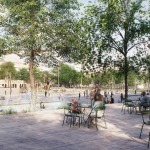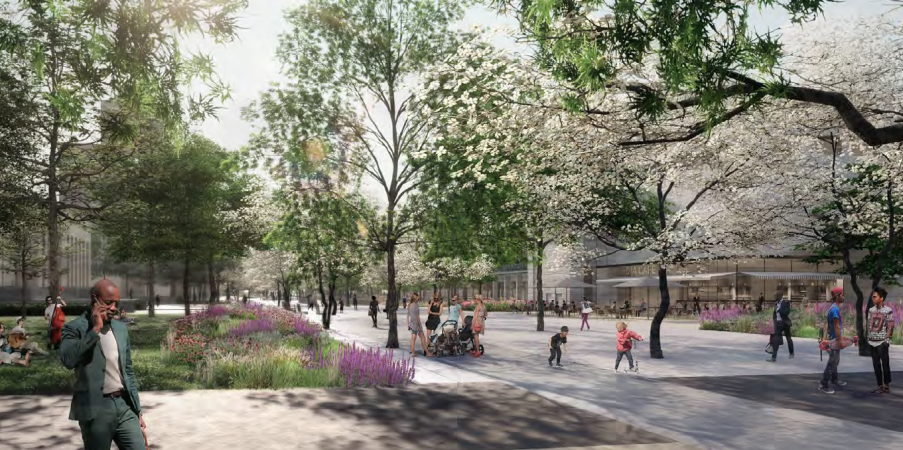Recently, Midtown Detroit Inc. (MDI) received a $12 million appropriation from the State of Michigan that will be used to support the Cultural Center Planning Initiative – a strategic effort to redefine the public space that connects twelve arts, cultural, and educational institutions across an 83-acre site in Midtown.
The collective goal is to strengthen the accessibility and walkability between the institutions, the surrounding community, the city, and the metro area. The vicinity will offer a beautiful series of settings that support all types of programming and diverse public art, along with updated infrastructure to address stormwater management, updated lighting, free Wi-Fi, new parking with EV charging stations, and more.
About the impetus behind the project, Sue Mosey, executive director of Midtown Detroit, Inc., says,
We have a great set of institutions that sit side-by-side that have never been connected. Each offers tremendous assets and programming and a broad demographic of visitors but until now, there has not been an intentional strategy to unite and connect all of them and offer a vibrant and thriving cultural destination.
The institutions include The Carr Center, Charles H. Wright Museum of African American History, College for Creative Studies, Detroit Historical Museum, Detroit Institute of Arts, Detroit Public Library, Hellenic Museum of Michigan, International Institute of Metropolitan Detroit, Michigan Science Center, The Scarab Club, University of Michigan and Wayne State University. Over the past year, these institutions have drawn more than 2.1 million visitors from across the country and the world.
The project – five years in the making – has required collaboration between all parties, lobbying at the state level, and many trips to Lansing. But Mosey says that all entities are aligned. “I think all parties understand that this combined collaborative vision will have a big impact on Detroit and the state of Michigan. The time is right for executing a bold visionary plan and creating a more compelling arts and culture experience for visitors and residents.”
The redesign focuses on the following main initiatives.
CREATING A PHYSICAL HUB
Currently, the area is not designed as a holistic destination, therefore visitors largely come to experience one institution at a time. The plan is to change that and position it as an arts and cultural hub.
Says Mosey, “This initiative will allow us to use the entire set of institutions to drive visitors and provide more holistic programming and services. We will be able to market this full footprint, not the singular institutions as has been done in the past.”
Shared programming between the institutions for local artists students and residents will also help facilitate this.
DIGITIZING FOR THE FUTURE
Digitizing the space will enhance and enliven the campus, which will include Wi-Fi and more.
Says Mosey, “We will offer digital activities, and digital art and the infrastructure will be designed and equipped to facilitate outside events so that entities do not have to bring in their own equipment.”
There will also be outdoor classrooms, pavilions, and spaces for outdoor engagement.
WALKABILITY
The design scheme will connect the institutions and their neighbors for a more organic experience.
“Visiting multiple institutions on foot is not intuitive,” says Mosey. “Easy access is not in place. It’s even hard to know what doors to go into. But we are looking at how to create walkways and wayfinding to facilitate a better experience. The width of streets will be reduced to increase greenspace and walkability as well.”
SUSTAINABILITY
The project will incorporate sustainability in many ways. A team of landscape architects and environmental engineers has been secured, including Ann Arbor-based Akoaki Architecture, Agence Ter out of Paris, and Drummond Carpenter. Each of them focuses on sustainability as a priority.
Sustainability will play itself out in many ways,” says Mosey. “One tangible and immediate example is stormwater management. This area has suffered significant damage due to flooding, so this is a top priority, and we are working with the city on this already. Managing stormwater with new infrastructure and design will help mitigate flooding, but also lends to redeveloping our streets and landscaping toward sustainability overall as well.”
The first phase of the project will result in an expansion of the existing tree canopy with 136 new trees.
In closing, Mosey comments on what this redesign means to the city and its residents, saying, “We know from our research that in the last year, 30% of those who visited the cultural center were Detroit residents. We want these residents to realize a direct benefit here. We are also creating something special that will generate more visitors and repeat visits from those in metro Detroit, the state, and beyond.”
As always, be sure to subscribe to our newsletter for regular updates on all things Detroit.























